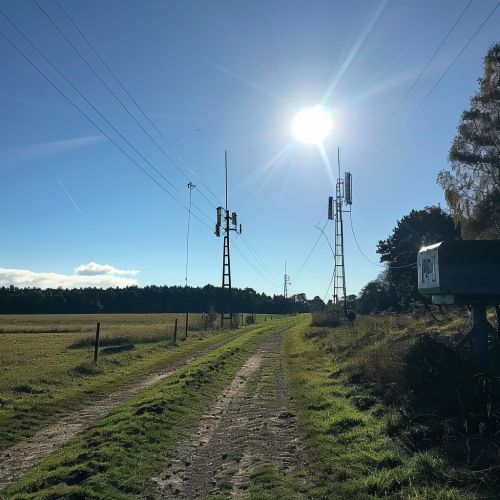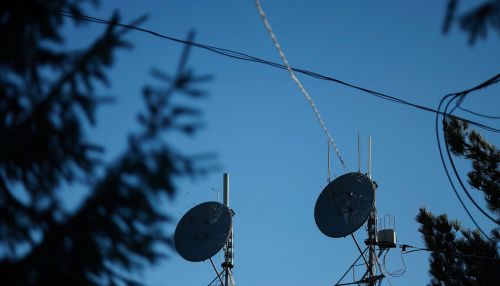Radio propagation
Introduction
Radio propagation is the behavior of radio waves as they travel, or propagate, from one point to another, or into various parts of the atmosphere. As a form of electromagnetic radiation, radio waves are affected by the phenomena of reflection, refraction, diffraction, absorption, polarization, and scattering. Understanding the effects of varying conditions on radio propagation has many practical applications, from choosing frequencies for international shortwave broadcasters, to designing reliable mobile telephone systems, to radio navigation, to operation of radar systems.
Types of Propagation
Radio waves may travel directly from the transmitting antenna to the receiving antenna (line-of-sight propagation), they may travel as ground waves, which follow the contour of the Earth, or they may be reflected from the ionosphere (skywave propagation). Beyond the horizon, skywaves are usually the main form of propagation. These modes of propagation are used in shortwave broadcasting, amateur radio, and certain state and military services.
Line-of-Sight Propagation


Line-of-sight propagation implies that there is an unobstructed path between the transmitting antenna and the receiving antenna. This type of propagation is primarily used in very high frequency (VHF) or ultra high frequency (UHF) frequency bands. It is also used for television broadcasting, cell phones, satellite communication, and wireless LANs.
Groundwave Propagation
Groundwave propagation occurs when radio waves travel along the Earth's surface. It is the primary means of propagation for AM broadcasting in the medium wave (MW) band and for shortwave broadcasting in the low frequency (LF) and very low frequency (VLF) bands. The waves are attenuated as they travel due to absorption in the ground and losses in the ionosphere.
Skywave Propagation
Skywave propagation, also known as ionospheric propagation, occurs when radio waves are reflected or refracted back to Earth from the ionosphere, an ionized layer of the Earth's atmosphere. It is used for long distance communication by shortwave radio, amateur radio operators, and military and state services. The ionosphere's ability to bend radio waves back to the Earth varies with the time of day, the season, and the solar cycle.
Factors Affecting Radio Propagation
Several factors can affect radio propagation, often causing the radio signal to take paths that are not line-of-sight.
Atmospheric Conditions
Changes in atmospheric conditions can cause radio signals to refract, or bend, as they travel through the atmosphere. This can cause the signal to travel further than it would under normal conditions, or it can cause the signal to be lost completely.
Terrain
The terrain over which the signal travels can also have a significant impact on radio propagation. For example, signals can be blocked by mountains or large buildings, or they can be reflected off bodies of water.
Frequency
The frequency of the radio signal also affects how it propagates. Lower frequency signals can often travel further than higher frequency signals, and are less likely to be absorbed by obstacles.
Antenna Characteristics
The characteristics of the transmitting and receiving antennas, such as their height, type, and orientation, can also have a significant impact on radio propagation.
Propagation Models
Propagation models are mathematical formulas used to predict the path loss of a radio signal as it travels from the transmitter to the receiver. These models take into account the factors that affect radio propagation, such as the frequency of the signal, the height and type of the antennas, the distance between the antennas, and the characteristics of the terrain over which the signal travels.
Free Space Propagation Model
The Free Space Propagation Model assumes that the radio signal is traveling in a vacuum, with no obstacles to block or reflect the signal. This model is often used as a baseline for comparing other propagation models.
Ground Reflection Model
The Ground Reflection Model takes into account the reflection of the radio signal off the ground. This model is often used for predicting the path loss of signals in the VHF and UHF bands.
Okumura Model
The Okumura Model is a popular model for predicting the path loss of urban cellular systems. It takes into account the effects of buildings and other obstacles on the radio signal.
Hata Model
The Hata Model is an empirical formulation of the Okumura Model. It is often used for predicting the path loss of signals in the 150 MHz to 1.5 GHz frequency range.
COST 231 Model
The COST 231 Model is an extension of the Hata Model, and is often used for predicting the path loss of signals in the 1.5 GHz to 2 GHz frequency range.
